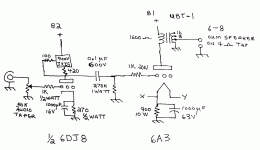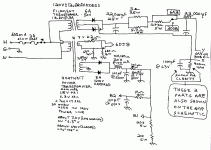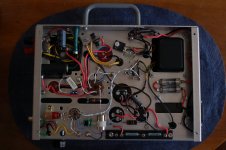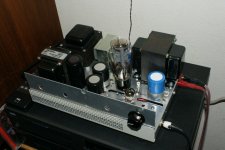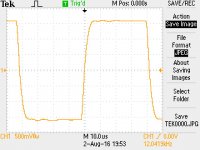Member
Joined 2009
Paid Member
Sounds interesting, but the pdf has only some text and we like to see schematics and photos 😀
"I designed and built a 6DJ8 6A3 mono block amplifier.
The goals were:
Single Ended, which is intrinsically Class A unless you like listening to clipping.
Low power dissipation, so I could listen on hot weather days to a cooler amp.
(Yes I know, Class A has lower efficiency and more heating than Class AB. But the tradeoff
was made for less parts and simplicity).
No feedback.
2 stages.
Good sounding (the listeners have to decide for themselves if it sounds good or bad).
Must work at near field or fairly close range for all the models of speakers I have (does not have
to fill the larger living room with sound).
Good measured performance for how it will be used.
The starting point was a Heath Kit Class AB push pull integrated EL84 amplifier. It previously
had been stripped down to just the small chassis and power transformer (that is all there was
when I got it).
There is a volume control at the input, so a CD player or Tuner, and loudspeaker is all that
is needed to play music.
One triode of a 6DJ8 is self biased, and uses a constant current plate load. The output is
RC coupled to the 6A3 grid. The 6A3 is self biased, and has DC on the filaments. An air
gapped output transformer matches the 6A3 to the loudspeaker.
The B+ uses HexFred rectifiers. It is choke loaded, for lower heating of the High Voltage
secondary winding. The filter is LC, RC, RC. The filament secondary lights the 6DJ8.
A second transformer was added to the chassis with a 12.6V center tapped secondary
connected to 6 Amp diodes driving a CRC filter to power the 6A3 filament.
The second half of the 6DJ8 is self biased, and has a large resistance plate load. This just
keeps the “unused” triode section operating with a little current. If the tube ever goes into
another amplifier, at least both sections have been tested and operated for the same amount of
time.
The filament C-R-C filter has one more feature. The R has a 2nd resistor in series.
There is a switch across that 2nd resistor.
Closed switch is for the 6A3, Open switch is for the 300B. Tube tasting anyone?
It is time to listen to some music. "
"I designed and built a 6DJ8 6A3 mono block amplifier.
The goals were:
Single Ended, which is intrinsically Class A unless you like listening to clipping.
Low power dissipation, so I could listen on hot weather days to a cooler amp.
(Yes I know, Class A has lower efficiency and more heating than Class AB. But the tradeoff
was made for less parts and simplicity).
No feedback.
2 stages.
Good sounding (the listeners have to decide for themselves if it sounds good or bad).
Must work at near field or fairly close range for all the models of speakers I have (does not have
to fill the larger living room with sound).
Good measured performance for how it will be used.
The starting point was a Heath Kit Class AB push pull integrated EL84 amplifier. It previously
had been stripped down to just the small chassis and power transformer (that is all there was
when I got it).
There is a volume control at the input, so a CD player or Tuner, and loudspeaker is all that
is needed to play music.
One triode of a 6DJ8 is self biased, and uses a constant current plate load. The output is
RC coupled to the 6A3 grid. The 6A3 is self biased, and has DC on the filaments. An air
gapped output transformer matches the 6A3 to the loudspeaker.
The B+ uses HexFred rectifiers. It is choke loaded, for lower heating of the High Voltage
secondary winding. The filter is LC, RC, RC. The filament secondary lights the 6DJ8.
A second transformer was added to the chassis with a 12.6V center tapped secondary
connected to 6 Amp diodes driving a CRC filter to power the 6A3 filament.
The second half of the 6DJ8 is self biased, and has a large resistance plate load. This just
keeps the “unused” triode section operating with a little current. If the tube ever goes into
another amplifier, at least both sections have been tested and operated for the same amount of
time.
The filament C-R-C filter has one more feature. The R has a 2nd resistor in series.
There is a switch across that 2nd resistor.
Closed switch is for the 6A3, Open switch is for the 300B. Tube tasting anyone?
It is time to listen to some music. "
Member
Joined 2009
Paid Member
Looks good to me. Of course, we know how important the power supply is in SE amps and you described on with plenty of filtering but I wasn't sure about the impedance of the supply filters and coils.
I have attached the schematic of the power supply.
Note: The very old Heath Kit transformer was for 115 to 117 VAC.
But my power line varies from 117 to 123 VAC.
That could be very hard on a transformer.
So ... I use a very light load on the filament winding (6DJ8).
And ... I use a choke input filter on the B+ secondary, not the
capacitor input filter of the original amp.
I run the B+ at lower DC current than the original amplifier. Those are
easy loads, and consequently the secondary voltages are higher,
requiring series resistors (2.2 Ohm for filament), and 180 Ohm (the choke).
I use a second transformer, rated for 120VAC.
The secondary is 12.6V, 3Amp, center tapped.
That powers the 1.0 Amp filament of the 6A3 (Summer time),
or 1.25 Amp filament of the 300B (I will try this winter).
Note: The very old Heath Kit transformer was for 115 to 117 VAC.
But my power line varies from 117 to 123 VAC.
That could be very hard on a transformer.
So ... I use a very light load on the filament winding (6DJ8).
And ... I use a choke input filter on the B+ secondary, not the
capacitor input filter of the original amp.
I run the B+ at lower DC current than the original amplifier. Those are
easy loads, and consequently the secondary voltages are higher,
requiring series resistors (2.2 Ohm for filament), and 180 Ohm (the choke).
I use a second transformer, rated for 120VAC.
The secondary is 12.6V, 3Amp, center tapped.
That powers the 1.0 Amp filament of the 6A3 (Summer time),
or 1.25 Amp filament of the 300B (I will try this winter).
Attachments
Here is a photo of the amplifier. It is pretty packed on the small
chassis. You can see the 6A3 filament switch marking.
(the 300B switch position marking is hidden by the Amperex 6DJ8.
It has been tested with a 300B, and listened to briefly.
But that operation is for Winter weather.
For a capacitor input filter, the peak current is much larger
than the DC current of the filament load.
DC 6A3 = 1 Amp, DC 300B = 1.2 to 1.35A filaments.
The Square of the filament currents are 1 Amp for the 6A3,
and 1.44 to 1.82 Amp for the 300B.
The transient loss in the filament transformer is I Squared R.
This happens during a short percentage of the time of each alternation.
There is quite a heating difference of the transformer secondary
for the 6A3 versus the 300B.
chassis. You can see the 6A3 filament switch marking.
(the 300B switch position marking is hidden by the Amperex 6DJ8.
It has been tested with a 300B, and listened to briefly.
But that operation is for Winter weather.
For a capacitor input filter, the peak current is much larger
than the DC current of the filament load.
DC 6A3 = 1 Amp, DC 300B = 1.2 to 1.35A filaments.
The Square of the filament currents are 1 Amp for the 6A3,
and 1.44 to 1.82 Amp for the 300B.
The transient loss in the filament transformer is I Squared R.
This happens during a short percentage of the time of each alternation.
There is quite a heating difference of the transformer secondary
for the 6A3 versus the 300B.
Attachments
Just an update on the 6A3 Cool Amp. A 2 Amp fast blow fuse is not big enough
for the 3 Amp or so instantaneous inrush and turn on, that is why I used a 3 Amp
fast blow fuse. But I finally got a 2.5 Amp fast blow fuse, and it holds OK for the
brief inrush current. That is just a little better protection than before. Don't forget
that the other protection for long term overload is provided by the 600 mA slow blow
fuse in series with the 2.5 Amp fuse.
for the 3 Amp or so instantaneous inrush and turn on, that is why I used a 3 Amp
fast blow fuse. But I finally got a 2.5 Amp fast blow fuse, and it holds OK for the
brief inrush current. That is just a little better protection than before. Don't forget
that the other protection for long term overload is provided by the 600 mA slow blow
fuse in series with the 2.5 Amp fuse.
Good measured performance for how it will be used.
Are you planning to post the measurements?
6A3 Summer Cool Amp
8 Ohm load used for all measurements
Sine wave barely visible mis shape at 4Vrms (2W), visible rounded clipping at 5Vrms (3.1W)
THD 5% at 2W, 2nd, 3rd, and 4th harmonics, others not visible (root sum square method)
Gain: 5.3 (14.5 dB)
Output Z: 3 Ohms Damping Factor 2.67 referred to 8 Ohms
Rise Time, Fall Time: 4.26 us Bandwidth: 82 kHz
Freq. Response 1 kHz ref., 2.828Vrms, 1 Watt, 8 Ohms: 19,999 Hz, -0.2 dB; 21.5 Hz, -1.7 dB
Hum: less than 100 uV into 8 Ohms
12 kHz Square Wave: small ringing at ~ 100 kHz ~ 3% (see screen shot)
Only affects the music if you have 100 kHz in the signal
IM Distortion, 1W, 250Hz/8020Hz 4:1: 2nd order IM 1.1%
IM Distortion, 1W, 11kHz/12kHz: 2nd order IM 2.4%, 3rd order IM 0.7% below each tone,
Total peak power of 2 tones is 6 dB larger than 1 tone.
Vrms Power 2nd Harmonic 3rd Harmonic 4th Harmonic
1 0.125W 0.8% 0.22% -
1.414 0.25W 1.26% 0.32% -
2 0.5W 1.51% 0.36% -
2.828 1W 2.2% 0.63% -
4 2W 4.78% 1.66% 0.38%
Reminder: this amp is used in a near field application. Most often, on music peaks, the voltage to the speaker is 2V peak or less (1.414Vrms).
8 Ohm load used for all measurements
Sine wave barely visible mis shape at 4Vrms (2W), visible rounded clipping at 5Vrms (3.1W)
THD 5% at 2W, 2nd, 3rd, and 4th harmonics, others not visible (root sum square method)
Gain: 5.3 (14.5 dB)
Output Z: 3 Ohms Damping Factor 2.67 referred to 8 Ohms
Rise Time, Fall Time: 4.26 us Bandwidth: 82 kHz
Freq. Response 1 kHz ref., 2.828Vrms, 1 Watt, 8 Ohms: 19,999 Hz, -0.2 dB; 21.5 Hz, -1.7 dB
Hum: less than 100 uV into 8 Ohms
12 kHz Square Wave: small ringing at ~ 100 kHz ~ 3% (see screen shot)
Only affects the music if you have 100 kHz in the signal
IM Distortion, 1W, 250Hz/8020Hz 4:1: 2nd order IM 1.1%
IM Distortion, 1W, 11kHz/12kHz: 2nd order IM 2.4%, 3rd order IM 0.7% below each tone,
Total peak power of 2 tones is 6 dB larger than 1 tone.
Vrms Power 2nd Harmonic 3rd Harmonic 4th Harmonic
1 0.125W 0.8% 0.22% -
1.414 0.25W 1.26% 0.32% -
2 0.5W 1.51% 0.36% -
2.828 1W 2.2% 0.63% -
4 2W 4.78% 1.66% 0.38%
Reminder: this amp is used in a near field application. Most often, on music peaks, the voltage to the speaker is 2V peak or less (1.414Vrms).
Attachments
- Status
- Not open for further replies.
- Home
- Amplifiers
- Tubes / Valves
- 6A3 Cool Amp
